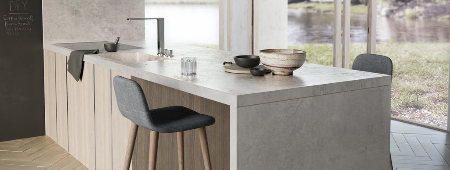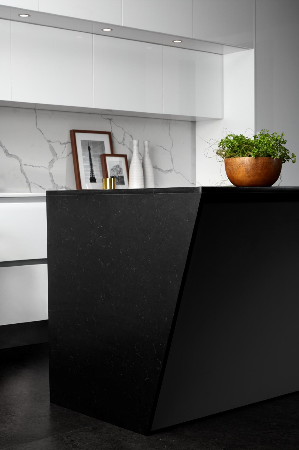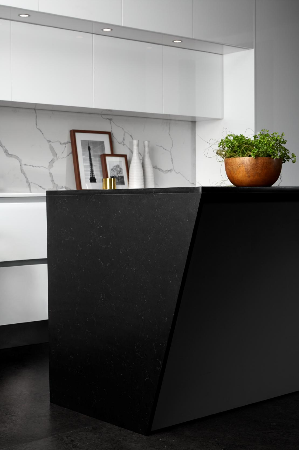Blog categories
Blog archive
RSS Blog posts tagged with 'countertop'
Blog Filters
Get Inspired by Cosentino's Kitchen Designs This MCO
Friday, November 20, 2020
We know it has been a tough period amid the Covid-19 global pandemic, and an ongoing month-long MCO. Do not worry as Cosentino Malaysia would like to offer you 3 simple solutions to how you can spend your time wisely. 1. Online shopping
We know you’ve missed going to malls, but we can offer you the next best thing! Our website (www.cosentino.com) is filled with an array of surfaces you can choose or get inspiration from for your next home project. If not, just check out our new collection, we promise it’s worth a scroll!
2. Design your own kitchen
With Cosentino Kitchen 3D (http://kitchen3d.cosentino.com/), you can make your dream kitchen come come alive with the creation of 3D images where you can configure the colour, the edge and the sink!
1. Online shopping
We know you’ve missed going to malls, but we can offer you the next best thing! Our website (www.cosentino.com) is filled with an array of surfaces you can choose or get inspiration from for your next home project. If not, just check out our new collection, we promise it’s worth a scroll!
2. Design your own kitchen
With Cosentino Kitchen 3D (http://kitchen3d.cosentino.com/), you can make your dream kitchen come come alive with the creation of 3D images where you can configure the colour, the edge and the sink!
 3. #wearehygiene
Share your tips/ habits of safety and hygiene in the kitchen/bathroom on FB and IG. Do tag @CosentinoAsia and hashtag #wearehygiene and #cosentinoMY, we would love to see your beautiful stories!
3. #wearehygiene
Share your tips/ habits of safety and hygiene in the kitchen/bathroom on FB and IG. Do tag @CosentinoAsia and hashtag #wearehygiene and #cosentinoMY, we would love to see your beautiful stories!
www.cosentino.com

How to Choose the Correct Kitchen Finishes and Materials
Friday, November 20, 2020
Whether you are decorating for durability or for eye-pleasing aesthetics, there are a multitude of factors to consider when selecting materials and finishes for your kitchen.
 Interior design by: Signature Kitchen
Interior design by: Signature Kitchen
At first glance, a kitchen in the making may only evoke concerns over its final appearance, but there's to more to it than meets the eye. Materials and finishes play an important role as well when it comes to the countertops, cabinetry, paint and backsplash features. Whether your style is traditional, transitional, or modern, focus on an overall theme as one of the first steps to selecting your materials. Aside from colour, it's also important to consider tone and texture to create an overall design that does not appear visually flat when the project is completed.
Laminates
 Interior design by: Regal Violet
Interior design by: Regal Violet
Being made of highly-compressed layers of wood and fabric soaked in resins, laminates provide a greater range of possible shades - in addition to the aesthetic quality of natural wood, combined with the relative durability of plastic resins. Laminates of the past may have garnered a reputation for being susceptible to high humidity and temperatures, but recent developments in the refinement of plastics have resulted in more accessible and durable laminates that are less likely to peel with moisture and age.
Natural Stone
 Interior design by: IDS Interior
Interior design by: IDS Interior
The irreproducible shades and veins of quarried stone panels make for truly unique countertops that project an image of individuality and prosperity - but being a material acquired from natural sources, quarried stones of matching shades are notoriously difficult to acquire in consistent quantities, making planning and acquisition the most crucial stages in the renovation of a kitchen with stone surfaces. The workability of stone does not compare to the ease of working with wood however, as various types of stone have an inherent propensity to chip in response to impact or crack from vibrations - which entails uniform sizes of panels and finishing details such as edge cuts to be affected by an experienced craftsperson.
Wood
 Interior design by: Q1 Interior Concept
Interior design by: Q1 Interior Concept
Natural wood, especially those selectively harvested from managed plantations, represent an increasingly popular choice among the ecologically conscientious and anyone seeking to recreate a cooking space from a simpler time. Wood is the simplest material to work with, and some of us may be immediately drawn to materials such as reclaimed wood planks to bedeck a kitchen in country style, but the porosity and propensity to absorb water in even the densest of hardwoods is cause for caution. Despite the physical drawbacks, the occasional authentic wooden element makes for a dramatic and nuanced contrast when presented in conjunction with other materials such as stone or steel.
Tiles
 Interior design by: ST Concepts
Interior design by: ST Concepts
While cutting, shaping, and polishing natural stone by hand is an art unto itself, the use of ceramic or porcelain tiles, or even pre-cut stone pieces, make the aesthetics of stone more accessible. Modern tiles can be manufactured to mimic the shades and patterns of natural stone, or to introduce designed patterns and colours, often rolling out of industrial ovens with varieties of matte or glossy sheens already baked in. As they are manufactured materials, most tiles composed of ceramic or porcelain require little to no chemical treatment after installation - however, much like pre-cut stone tiles, ceramic and porcelain tiles must be bordered with grout to adhere the tiles and prevent them from impacting each other.
Stainless Steel
 Interior design by: Creative Steel
Interior design by: Creative Steel
Any commercial entity with its livelihood based on the preparation of food depends on a kitchen furnished with stainless steel surfaces. The accessibility, durability, and chemical resistance of steel are unmatched by all other materials - with the sole exception of quartz. High-gauge stainless steel is strong, yet thin enough to be easily workable, but countertops will show visible dents without a cushioning layer of hardwood to absorb impacts. Besides providing a reflective sheen that complements modern kitchens and visually expands compact spaces, stainless steel is a practical choice for countertops as it is able to withstand high temperatures without conducting heat away from the source.
Cement
 Interior design by: Homlux Interior Furnishing
Interior design by: Homlux Interior Furnishing
Where stone and tiles typically restrict designs to dimensions predetermined by suppliers and manufacturers, the use of cement to render surfaces opens the door on all kinds of creative expressions in post-industrial style. Much like natural stone, cement is susceptible to impact damage and has a porosity that must be addressed by the application of chemical treatments to prevent stains. Without a sealing coat, cement surfaces tend to appear matte when cured, with a tendency towards displaying unpredictable streaking of limescale when fully dried. Aged cement surfaces accumulate an irreproducible polish and characteristic patina over time, a feature that is warming and comforting to those seeking a vintage-industrial décor.
Engineered Quartz
 Interior design by: Turn Design
Interior design by: Turn Design
With engineered stone surfaces such as quartz, the shades and veins of natural stone are made more accessible with recent improvements in adhesives. Unlike naturally quarried stone, engineered quartz is non-porous and much more readily available - being composed of synthetic polymers and otherwise unused flecks from the same quarries supplying the world’s most recognizable types of marble. The majority of the blend being quartz - one of the Earth’s hardest minerals, the finished product is a surface that withstands more physical damage, chemicals, as well as fluctuations between temperature extremes, even when compared with the densest of natural stones. Consequently, it is also one of the most difficult materials to work with, limiting the supply and installation of this material to a select network of manufacturers and applicators.
Solid Surface
 Interior design by: Design Integra
Interior design by: Design Integra
Much like cement, solid surfaces can be seamlessly rendered in curved profiles while the material is still in its uncured slurry state. Unlike cement, solid surfaces are shaped at the point of manufacture much like quartz panels are, but their inherent workability permits shaping during installation and repairs by grinding or polishing. Being manufactured in a similar manner as quartz, the designs and shades of solid surfaces among the world’s various suppliers are highly varied - but while quartz can be identified as being composed of a single type of mineral, solid surfaces may be based on softer minerals, or contain a mixture of minerals to achieve a balance of aesthetics and workability.
Glass
 Interior design by: Homlux Interior Furnishing
Interior design by: Homlux Interior Furnishing
If the reflective quality of stainless steel seems to fall short of expectations, consider using glass on the backsplash, or to finish the fronts of cabinets instead. Whether opaque or transparent, glass adds a delicate layer of modern elegance to kitchens - especially when used in conjunction with other disparate materials such as wood, stone, or steel. Glass panes can also be used to protect porous materials such as wood or stone from moisture and stains by being fixed over the more absorbent materials. The aesthetic qualities of glass do come with a rather widely-understood caveat: being a crystalline structure locked in a stable state by heat and pressure, glass is susceptible to impact damage and extreme temperature fluctuations -necessitating caution in its use on surfaces where heavy objects such as pots and pans are likely to land with some force.

How to Choose the Correct Kitchen Finishes and Materials
Friday, November 20, 2020
Whether you are decorating for durability or for eye-pleasing aesthetics, there are a multitude of factors to consider when selecting materials and finishes for your kitchen.
 Interior design by: Signature Kitchen
Interior design by: Signature Kitchen
At first glance, a kitchen in the making may only evoke concerns over its final appearance, but there's to more to it than meets the eye. Materials and finishes play an important role as well when it comes to the countertops, cabinetry, paint and backsplash features. Whether your style is traditional, transitional, or modern, focus on an overall theme as one of the first steps to selecting your materials. Aside from colour, it's also important to consider tone and texture to create an overall design that does not appear visually flat when the project is completed.
Laminates
 Interior design by: Regal Violet
Interior design by: Regal Violet
Being made of highly-compressed layers of wood and fabric soaked in resins, laminates provide a greater range of possible shades - in addition to the aesthetic quality of natural wood, combined with the relative durability of plastic resins. Laminates of the past may have garnered a reputation for being susceptible to high humidity and temperatures, but recent developments in the refinement of plastics have resulted in more accessible and durable laminates that are less likely to peel with moisture and age.
Natural Stone
 Interior design by: IDS Interior
Interior design by: IDS Interior
The irreproducible shades and veins of quarried stone panels make for truly unique countertops that project an image of individuality and prosperity - but being a material acquired from natural sources, quarried stones of matching shades are notoriously difficult to acquire in consistent quantities, making planning and acquisition the most crucial stages in the renovation of a kitchen with stone surfaces. The workability of stone does not compare to the ease of working with wood however, as various types of stone have an inherent propensity to chip in response to impact or crack from vibrations - which entails uniform sizes of panels and finishing details such as edge cuts to be affected by an experienced craftsperson.
Wood
 Interior design by: Q1 Interior Concept
Interior design by: Q1 Interior Concept
Natural wood, especially those selectively harvested from managed plantations, represent an increasingly popular choice among the ecologically conscientious and anyone seeking to recreate a cooking space from a simpler time. Wood is the simplest material to work with, and some of us may be immediately drawn to materials such as reclaimed wood planks to bedeck a kitchen in country style, but the porosity and propensity to absorb water in even the densest of hardwoods is cause for caution. Despite the physical drawbacks, the occasional authentic wooden element makes for a dramatic and nuanced contrast when presented in conjunction with other materials such as stone or steel.
Tiles
 Interior design by: ST Concepts
Interior design by: ST Concepts
While cutting, shaping, and polishing natural stone by hand is an art unto itself, the use of ceramic or porcelain tiles, or even pre-cut stone pieces, make the aesthetics of stone more accessible. Modern tiles can be manufactured to mimic the shades and patterns of natural stone, or to introduce designed patterns and colours, often rolling out of industrial ovens with varieties of matte or glossy sheens already baked in. As they are manufactured materials, most tiles composed of ceramic or porcelain require little to no chemical treatment after installation - however, much like pre-cut stone tiles, ceramic and porcelain tiles must be bordered with grout to adhere the tiles and prevent them from impacting each other.
Stainless Steel
 Interior design by: Creative Steel
Interior design by: Creative Steel
Any commercial entity with its livelihood based on the preparation of food depends on a kitchen furnished with stainless steel surfaces. The accessibility, durability, and chemical resistance of steel are unmatched by all other materials - with the sole exception of quartz. High-gauge stainless steel is strong, yet thin enough to be easily workable, but countertops will show visible dents without a cushioning layer of hardwood to absorb impacts. Besides providing a reflective sheen that complements modern kitchens and visually expands compact spaces, stainless steel is a practical choice for countertops as it is able to withstand high temperatures without conducting heat away from the source.
Cement
 Interior design by: Homlux Interior Furnishing
Interior design by: Homlux Interior Furnishing
Where stone and tiles typically restrict designs to dimensions predetermined by suppliers and manufacturers, the use of cement to render surfaces opens the door on all kinds of creative expressions in post-industrial style. Much like natural stone, cement is susceptible to impact damage and has a porosity that must be addressed by the application of chemical treatments to prevent stains. Without a sealing coat, cement surfaces tend to appear matte when cured, with a tendency towards displaying unpredictable streaking of limescale when fully dried. Aged cement surfaces accumulate an irreproducible polish and characteristic patina over time, a feature that is warming and comforting to those seeking a vintage-industrial décor.
Engineered Quartz
 Interior design by: Turn Design
Interior design by: Turn Design
With engineered stone surfaces such as quartz, the shades and veins of natural stone are made more accessible with recent improvements in adhesives. Unlike naturally quarried stone, engineered quartz is non-porous and much more readily available - being composed of synthetic polymers and otherwise unused flecks from the same quarries supplying the world’s most recognizable types of marble. The majority of the blend being quartz - one of the Earth’s hardest minerals, the finished product is a surface that withstands more physical damage, chemicals, as well as fluctuations between temperature extremes, even when compared with the densest of natural stones. Consequently, it is also one of the most difficult materials to work with, limiting the supply and installation of this material to a select network of manufacturers and applicators.
Solid Surface
 Interior design by: Design Integra
Interior design by: Design Integra
Much like cement, solid surfaces can be seamlessly rendered in curved profiles while the material is still in its uncured slurry state. Unlike cement, solid surfaces are shaped at the point of manufacture much like quartz panels are, but their inherent workability permits shaping during installation and repairs by grinding or polishing. Being manufactured in a similar manner as quartz, the designs and shades of solid surfaces among the world’s various suppliers are highly varied - but while quartz can be identified as being composed of a single type of mineral, solid surfaces may be based on softer minerals, or contain a mixture of minerals to achieve a balance of aesthetics and workability.
Glass
 Interior design by: Homlux Interior Furnishing
Interior design by: Homlux Interior Furnishing
If the reflective quality of stainless steel seems to fall short of expectations, consider using glass on the backsplash, or to finish the fronts of cabinets instead. Whether opaque or transparent, glass adds a delicate layer of modern elegance to kitchens - especially when used in conjunction with other disparate materials such as wood, stone, or steel. Glass panes can also be used to protect porous materials such as wood or stone from moisture and stains by being fixed over the more absorbent materials. The aesthetic qualities of glass do come with a rather widely-understood caveat: being a crystalline structure locked in a stable state by heat and pressure, glass is susceptible to impact damage and extreme temperature fluctuations -necessitating caution in its use on surfaces where heavy objects such as pots and pans are likely to land with some force.

愛下廚的你絕不能錯過!最新廚房廚具設計|Top Trends In Kitchen Design 2019
Friday, November 20, 2020
新年前,网路上的热搜空间——厨房,成了大家的焦点词汇。“什么样的厨房设计,你最喜欢?”





